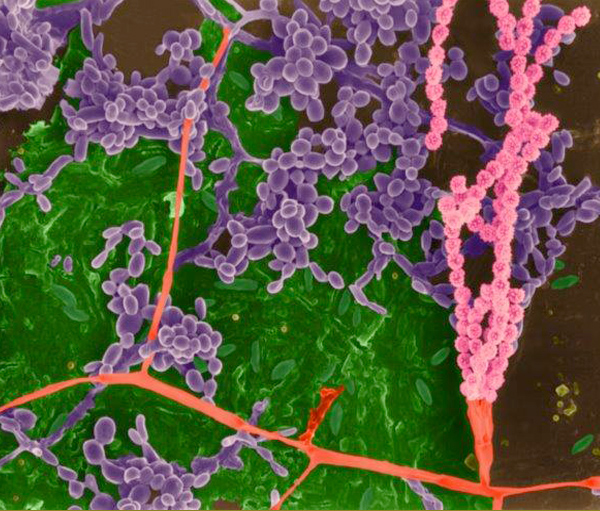
© Dennis Kunkel Microscopy
Meningitis is infection and inflamation of the meninges (the membranes that cover the brain and the spinal cord). Meningitis can be caused by bacteria, viruses, fungi and parasites.
What are the common agents that cause meningitis?
- Viral meningitis - The most common but less serious form of meningitis. Enteroviruses are the most common viral cause of meningitis in the US. Coxsackie, herpes virus, arbovirus, measles and varicella are other common meningitis causing viruses.
- Bacterial meningitis - An acute and dangerous form of the disease associated with classical symptoms. Common bacteria that cause meningitis depends on the age of the patient. Infants are commonly affected by Streptococcus pneumonia, Listeria, E. coli and Hemophilus influenzae. Meningococcus (Neisseria meningitidis) is the commonest causative in adolescents and middle aged individuals, while Streptococcus pneumonia is again the most common causative bacterial organism causing meningitis in the elderly. Mycobacterium are also a causative of meningitis.
- Fungal - Cryptococcal meningitis is a serious and fatal form of the disease in patients with HIV/AIDS and a CD count of <200. Candida and aspergillus are other examples of fungi associated with meningitis.
Parasites such as Nigleria fowleri and Acanthamoeba species are also etiologic agents of meningitis.
What are the signs and symptoms of meningitis?
Although the signs and symptoms of meningitis are dependant on the agent and the age of the patient, most cases manifest with high fever, headaches, and a stiff neck. These primary symptoms can be accompanied by nausea, vomiting, photophobia, confusion and irritability. Some of these classic signs and symptoms cannot be detected in an infant in whom lethargy and irritability are important signs.
Who are more susceptible to meningitis?
Meningitis occurs in people of all age groups, but very young individuals (infants and young children) and elderly individuals (>60 yrs) are more predisposed to the infection. Depending on their ages, individuals are also predisposed to certain etiologic agents.
Incubation Period
The incubation period depends on the causative agent. For example the incubation period of meningococcal meningitis is 2-10 days while the incubation for hemophilus meningitis is much shorter ranging from 2-4 days. However the range of incubation for most organisms causing meningitis is 2 days to 2 weeks.
Epidemiology of Meningitis
Infection of the meninges can be by direct infection but more probably is secondary to an ascending infection from another part of the body. The infection could primarily be in the skin, respiratory tract, nasopharynx or even the intestinal tract or genitourinary tract. The most common source however is the respiratory tract. The agents reach the meninges from the bloodstream or directly from a nearby infection such as an ear infection or nasopharynx. Once the agents enter the nervous system, they survive well because of the lack of immune response in the nervous system.
Diagnosis
The first step in the diagnosis of meningitis is by culture and analysis of the spinal fluid (cerebrospinal fluid, CSF). Spinal fluid is obtained by inserting a needle into the meninges of the spinal cord. CSF analysis helps determine if the causative organism is a bacteria, virus, mycobaterium or otherwise. The culture helps to identify the definitive organism.
Treatment
The treatment again depends on the causative organism. When meningitis is first suspected, broad spectrum antibiotics should be instituted depending on the age group of the patient (to cover for bacterial causes- as early treatment in such cases is vital). For example an infant should be started on Ampicillin plus cefotaxime plus vancomycin while an elderly person should be started on Ceftriaxone plus vancomycin. After the organism has been isolated from the CSF appropriate organism specific treatment should be instituted. Viral meningitis is treated supportively, and is not serious unless accompanied by encephalitis.
Contact EHA Consulting Group today for more information about how we can assist your company.
We offer services for
- Retail Food Safety
- Restaurant Food Safety
- Manufacturers
- Food Trucks
- Drugs & Cosmetics
- Melons & Cantaloupes
- Produce
- Warehouses
- Food Packaging & Packaging Materials